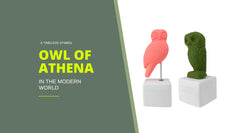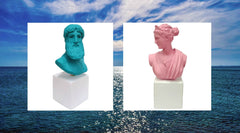Greek Statues in Color and the Myth of Whiteness in Ancient Sculptures
Excerpt - Greek Statues Were Colorful [Short Version):
This article debunks the misconception of whiteness in ancient Greek sculptures, asserting that they were originally colorful.
It discusses historical perspectives, refutes arguments against polychromy, and cites evidence from Pompeii and the Acropolis.
The article explores the use of colors in ancient Greece, the disappearance of ornaments during Pericles' reign, and their resurgence in Hellenistic times.
It mentions a modern exhibition, "Gods in Color," showcasing reconstructions of original colors.
The piece touches on debates about ancient Greeks' color perception and introduces a contemporary interpretation of colored Greek statues.
Greek statues were in color.
There was color in ancient Greece everywhere. The colors of nature under the bright Greek light were not the only ones.
Greek artistic and architectural creations were painted and full of bright colors.
Unraveling the misconception of whiteness in Greek sculptures
"Since the white color is that which sends back the most rays of light, thus making itself more sensitive: so also a beautiful body will be the more beautiful, the whiter it is“.
This is how the father of scientific archaeology Johann Winckelmann defined the classicist ideal of beauty in 1764.
The white marble thus became the aesthetic norm for ancient art and thus for art itself.
Ideology conquers the visible
However, ancient sculptures were not white but colorful. The colors have simply faded during the centuries. If sculptures with traces of paint were found, they were said to have been painted later by barbarians or that they were a relic from an earlier more primitive stage.
These arguments were first refuted by the findings of Pompeii in the 18th century, where lava preserved the colors, and later in the 19th from the Acropolis in Athens, which were preserved in the earth.
But theories and ideologies survived. The aesthetics of fascism returned to the ideal of the classical white, and after the Second World War few scientists were interested in polychromy.
Ancient Greek sculptures were colored
In any case: Today we know for sure that all sculptures were painted throughout.
Check this video and see part of the science behind this statement:
The importance of colors at that time can be seen from the following:
As the Roman author Pliny the Elder ( 23-79 ) wrote, Praxiteles (one of the most important sculptors of the ancient world) was once asked which were his best sculptures. He answered: "The ones on which Nikias laid his hand" – Nikias was Praxiteles favorite painter.
Legend says that the Gauls before Delphi have been frightened back by an army of statues on the terraces of the temple! So alive was the illusion through the painted sculptures.
How were the colors used in ancient Greece?
It seems that in archaic times, painters used only pure colors and applied them delimited next to each other, but that later colors were mixed and used to create spatial effects.
It is interesting that during the reign of Pericles ornaments practically disappeared from Greek art; this has been interpreted as a demarcation against the Persians with their extensive use.
During the time of Alexander the Great and Hellenism, ornamentation returned.
Greek statues in original colors
In modern times, scientific methods are used to make the colors visible again.
An exhibition Gods in Color has been touring the world since 2003 and can right now be seen in Frankfurt, Germany with new findings and reconstructions never before displayed.
The bright colors and rich ornaments indicate that the ancient Greeks were probably not "classically" strict, requiring a distance, but rather joyful and sensual, with which one can easily identify today.
Ancient Greeks and the perception of colors
Another widespread theory, that the ancient Greeks simply did not see colors or at least saw them differently is another story. The very interesting discussion in the color seeing continues. More of this another time.
Contemporary Greek statues interpretation
Don't miss to check this collection of colored Greek statues, heads and busts in a different, monochromatic and contemporary way and read about this aesthetic in a contemporary environment,
All made in Athens by SOPHIA enjoy thinking, which established a new trend in contemporary Greek gifts and souvenirs.

References and further reading:
- Johann Winckelmann: History of ancient art
- Gottfried Semper (German, 31.6MB pdf): Vorläufige Bemessungen über bemalte Architektur und Plastik bei den Alten-Altona, 1834
Write your thoughts about color in Greek statues in a comment and Share!



















